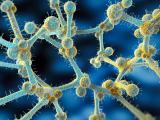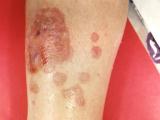Oct 19, 2012 (CIDRAP News) – A medical team from Tennessee today described the diagnosis and medical care of the first patient sickened in the ongoing fungal meningitis outbreak, the case that triggered an investigation by the state's public health officials and led to the uncovering of the problem.
The patient, who died of a stroke after the fungus invaded the blood vessels in his brain, was a man in his 50s who started having headache and neck pain about 4 weeks after receiving the last in a series of epidural injections of methylprednisolone for low-back pain. Doctors from Vanderbilt University School of Medicine who were involved in the case reported their findings today in an early online article in the New England Journal of Medicine (NEJM).
Since the man's infection was identified, the number of people sickened in the multistate outbreak has climbed to 271, with 14 more cases reported since yesterday, the US Centers for Disease Control and Prevention (CDC) said today in its latest update. One more death was reported, pushing that total to 21. The number of states affected remained at 16.
The patient received a thorough work-up, including cerebrospinal fluid testing, during his first hospitalization for worsening headache and neck pain. Routine bacterial cultures were negative. The initial diagnosis was presumed community-acquired meningitis, and the patient was discharged after his condition improved with antibiotic, opiate, and nonsteroidal anti-inflammatory drug treatment.
A week later he was hospitalized again with worsening headache, back pain, and new neurologic symptoms. Over the next 2 days his symptoms improved, but by day 6 his condition started to deteriorate. His doctors began empiric treatment with liposomal amphotericin B, and the following day the hospital's lab found Aspergillus fumigatus in the cerebrospinal fluid sample collected the first day of the man's hospitalization.
The physicians added intravenous voriconazole to his treatment regimen and started looking for clues to the fungal source of the infection, but a computed tomography (CT) scan of the chest showed no sign of fungal infection. Magnetic resonance imaging (MRI) of the brain showed midbrain and cerebellar infarcts, but an exam of the paranasal sinuses revealed nothing unusual.
On the eleventh day of hospitalization the man became unresponsive and had seizure symptoms. Cerebral imaging studies suggested an intraventricular hemorrhage with evidence of a mycotic aneurysm. Though cerebrospinal test findings and seizure activity improved, his doctors saw no neurologic recovery. He died 11 days later, after MRI showed new infarcts and the family decided not to pursue aggressive therapy, given the severity of the patient's injuries.
In an autopsy, investigators couldn't identify any typical fungal entries into the central nervous system, such as though a paranasal sinus or lungs. They began suspecting the epidural injection when they saw gray discoloration of the lumbar epidural compartment and brown leptomeningeal discoloration that spanned the length of the spinal cord, along with lab evidence of fungal invasion. Also, they found no other infarcts outside the patient's central nervous system.
They took their suspicions about the epidural injection as the route of exposure to the Tennessee Department of Health, which launched an investigation that led to the identification of the multistate outbreak.
Though Aspergillus infections of the central nervous system have a poor prognosis, early diagnosis and treatment can improve outcomes, the authors wrote. They said symptoms that persist despite empiric therapy should prompt tests for atypical pathogens..
In an accompanying review of what's known so far about the illness course of patients infected in the outbreak, infectious disease experts from the University of Michigan, University of Alabama, and University of Texas Health Science Center in San Antonio wrote that what's most intriguing about the index case is that the meningitis was caused by Aspergillus fumigatus, which hasn't been detected in any of the other outbreak patients. Health officials have reported that all of the other confirmed cases involved Exserohilum rostratum, which they describe as an even rarer source of human infections.
Yesterday doctors from Maryland described a fatal case of Exserohilum rostratum meningitis in another index patient, a 51-year-old woman who got sick a week after receiving a cervical epidural injection. They published their report in Annals of Internal Medicine.
The NEJM authors noted that shortly after the TDH was notified on Sep 18, the implicated steroid lots were quickly identified, centers that received the drugs were alerted, and patients who receive the drugs were notified.
They pointed out that black molds including Exserohilum have been linked to past outbreaks, including a "disturbingly similar" one in 2002 tied to contaminated steroid injections from a compounding pharmacy and other outbreaks related to contaminated water.
Though the authors noted that the outbreak and clinical picture are evolving, they offered several tips for clinicians concerning what's currently known about the symptom profiles, diagnosis, and treatment.
See also:
Oct 19 N Engl J Med case report
Oct 19 N Engl J Med review article
Oct 19 CDC outbreak update
Oct 18Ann Intern Med abstract



















